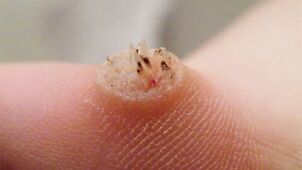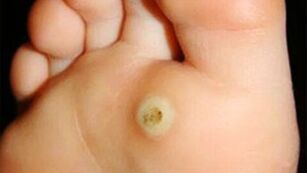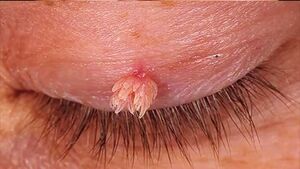
Warts are benign tumors with little loss of aesthetics, appearing on the skin when infected with human papillomavirus. When entering the upper layers of the epidermis, the virus stimulates the proliferation of cells, resulting in the appearance of warts of various shapes, sizes and colors.
The human papillomavirus infects about 80% of people on the planet and not all patients know their diagnosis, since HPV in most cases has no symptoms.
Types of warts
There are different types of warts depending on the position of the body, color, size, shape and type of pathogen.
Common warts or vulgar warts
Most commonly, their appearance does not depend on the age or sex of the patient. They are located on the hand, between the fingers, on the back of the palm (less often on the palm itself). The warts are round or irregular in shape, and due to their fleshy pink color, are often not easily visible on the skin. Dimensions vary from 1 to 3 mm; with long-term and untreated infection, groups of tumors may appear on the affected area.
Flat warts
Tumors of this species appear more often in children and teenagers, hence their second name being juvenile warts. These are fleshy nodules or light brown, oval or round, smooth surface, slightly raised on the skin. Mainly localized on the skin of the face, neck, arms and upper body.

Tree warts
This type of warts only appears on the skin of the feet, that's why it has its name. It is a rough growth with a keratinized skin layer or a group of such growth spots. The skin around the wart loses its natural color and becomes a grayish-yellow color. The surface of the wart hardens and begins to press on the surrounding healthy tissues, causing severe discomfort.
Hanging warts
The distinctive feature of this species is the presence of a narrow joint to the surface of the skin, the so-called "legs". The hanging warts may be elongated, round or uneven, pink or reddish. Such warts are localized on the neck, face, armpits, and under the breasts in women. Normally, the appearance of many hanging warts signals a sharp decrease in the body's immune status.
Warts in old age
These warts are more likely to affect the skin of older people. These are also known as seborrheic warts or keratoses. They develop due to age-related changes and metabolic deterioration from the cells of the epidermis, which typically occupy the upper part of the hair follicle. Keratomas are round, clearly defined, localized on the scalp or on the face. Dimensions vary from a few millimeters to 4-5 centimeters.

Genital warts
Genital warts or warts are the most annoying and painful cancers. Their pathogens are human papillomavirus types 6 and 11. Genital warts affect the skin adjacent to the mucosa: on the lips and eyelids; in the genitals, urethra, anus.
Genital warts are structured as papules that usually grow in comparison to a cauliflower or wart. Condylomas are connected to the skin surface by a thin "leg". Due to localization in areas of the body that are susceptible to mechanical irritation, warts and neighboring tissues are damaged to a high degree, infection and the development of an inflammatory process with the formation of secretions or pus.
The cause of the warts
The increase in human papilloma virus activity in the body leads to the appearance of warts. Infection occurs through contact and everyday life: through touching, shaking hands, common objects and public places if personal hygiene is not observed. Genital warts are sexually transmitted.
The virus will switch to active form if elements like:
- severe or chronic stress;
- transfer infectious diseases;
- reduced immunity;
- hormonal disturbances, improper metabolism;
- sweating a lot;
- skin trauma and minor trauma;
- wears clothes and shoes made of unnatural materials.
If the disease has no symptoms, it can only be diagnosed with laboratory testing.
Adult warts
The appearance of papillomas or warts can occur at any age. In this case, sex doesn't play a special role - both men and women are susceptible to HPV infection. At the same time, the risk of developing warts in women is higher, as their immunity is often impaired due to hormone levels, pregnancy and lactation. Due to the specific anatomical structure, women are also very susceptible to genital warts, particularly genital warts, which increases the risk of cervical cancer.
In men, warts appear only in the case of a drastic decrease in immunity, which doesn't happen often with people who have sex with more force. At the same time, it is extremely rare for men to carry the HPV viruses types 16 and 18, which are the cause of all cancers.
Childhood warts
Warts usually occur in children and teenagers, because their immunity is not fully formed, so they are susceptible to papillomavirus infection. As a rule, children going to kindergarten and school are in a state of increased stress, which negatively affects the body's ability to defend itself, plays an important role. In addition to infection by family contact, intrauterine infection from the mother can also occur.
Usually, children develop oral warts, adolescent warts, or warts, while teenage warts disappear on their own at the age of 14-18.

Treating warts
When treating warts, understand that it is impossible to completely remove the pathogen from the body - the virus that causes papillae in humans. Once in the body, it will last forever, but a healthy immune system can keep it under control and minimize the manifestations of its vital activity.
The fact that the appearance of warts indicates a weakening of the body's immune status, therefore, HPV therapy should include measures to strengthen the immune system. With a reduced body's defense response, even if the warts are removed successfully, there is a high chance of recurrence. However, in people with strong immunity, the warts can go away on their own.
Therapy should be selected by a competent physician after thorough examination. Self-medication is unacceptable, since a layman cannot distinguish warts from malignant cancer. The question of removingwarts is also determined by the specialist - an injured tumor can degenerate from benign to malignant.
There are the following ways to remove warts.
- Cryodestruction (frozen with liquid nitrogen). This method is especially effective for common warts. Tumors are exposed to liquid nitrogen for 10-30 seconds. This method is good for less trauma; It takes 1 to 5 treatments to completely get rid of warts.
- Laser coagulation (laser removal). The tumor is partially removed under local anesthesia. At the site of the wart, a furrow remains and will disappear after about a month.
- Condenser (removed with current). The warts are removed with a thin metal ring using high frequency currents. This method is characterized by no bleeding and additional tissue disinfection. The cancerous tissues are still intact, so they can be sent for histological examination. The manipulation trail disappeared within a week.
- Surgical removal. This method is used only in extreme cases, when the tumors are too large or grouped into a single set. Under local anesthesia, the warts are removed with a scalpel as in conventional surgery. The removed material is sent for histological examination. The presence of scars at the site of the removal depends on the surgeon's skill in applying the stitches.
- A chemical attack method that uses different acids or alkalis. This method is most painful, traumatic and dangerous because the risk of a secondary tissue infection at the site of contact is very high. When deciding to use it, it is worth remembering that you can only act on the wart without affecting the nearby skin.
Medicine for the treatment of warts
Local remedies are used to treat warts, but their effectiveness depends on the age of the tumor - the fresher the wart, the higher its ability to remove it and the patient's immunity.
Before using topical remedies, you should consult a dermatologist and do tests to determine the nature of the tumor, as exposure to drugs can causeThe wart cells degenerate into malignant.
Non-traditional wart treatments
Traditional recipes using:
- garlic;
- bows;
- royal tree;
- promote; wormwood
- ;
- flax oil.
Traditional medicine is a good adjunct to mainstream therapy after consulting a doctor.
Warts prevention
The best way to prevent the appearance of warts is to follow the rules of personal hygiene: wash your hands promptly, use personal nail accessories, towels, wipes, shoes. You should not walk barefoot in swimming pools, shared baths, bathtubs and saunas. Also, when staying in the hotel, you should bring disinfectants to bathroom treatment. In parallel, it is necessary to strengthen the immune system and take care of the general health condition.

























